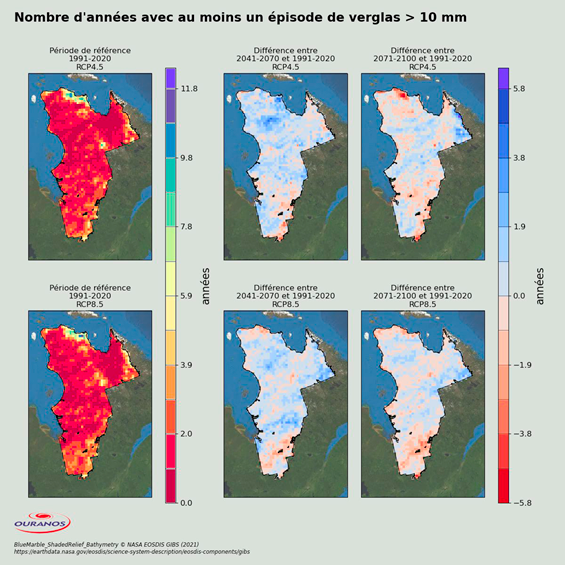A regional climate portrait in reference and future climates to support the analysis of impacts and adaptation to climate change in Eeyou Istchee James Bay, northern Abitibi-Témiscamingue and Nunavik
The results of this project provide a more complete and precise regional climatic and hydrological portrait in current and future climates to support decision-making on the identification of impacts and adaptation solutions to be planned and implemented for transportation.
Project details
Principal(s) investigator(s)


Context
The Ministère des Transports du Québec (MTQ) plays an important role in the design and maintenance of various works and infrastructure. In doing so, it must have information on the climatic conditions of the regions where this infrastructure is located, including the administrative region of Nord-du-Québec (Eeyou Istchee James Bay and Nunavik - EIJBN) and northern Abitibi-Témiscamingue, which are expected to experience significant changes in future climate conditions.
The existing regional portrait of the future climate in EIBJN and northern Abitibi-Témiscamingue and of certain climate indicators related to extremes in Nunavik is not complete enough to support decision-making on the identification of impacts and adaptation solutions to be planned and implemented for transportation. This project produced information that will guide the MTQ in its decisions.
Objective(s)
-
To improve and develop climate and hydrological knowledge for the EIJBN region and northern Abitibi-Témiscamingue to support the MTQ in planning, designing, maintaining and managing transportation infrastructure
-
To develop a body of knowledge to take climate change into account in transportation planning and interventions and related fields in order to ensure the sustainable development of EIJBN and northern Abitibi-Témiscamingue
Methodology
-
Update of basic climate indicators in Nunavik, focusing on Eeyou Istchee James Bay and northern Abitibi-Témiscamingue
-
Addition of new analyses of specific variables required by the MTQ such as freezing rain and extreme precipitation (intensity-duration-frequency curves)
-
Calculation of hydrological indicators of interest in transport infrastructure planning
Results
The project made it possible to provide the MTQ with the most up-to-date information on current (1991-2020) and future (2041-2070 and 2071-2100) climatic and hydrological conditions in the regions of Nord-du-Québec (EIJBN) and northern Abitibi-Témiscamingue for climatological indicators of temperature (15), precipitation (4), snow on the ground (2) and freezing rain (4), for extreme precipitation indicators and for hydrological indicators (3).
The results are presented in the form of maps, graphs and tables in the appendices, including local information for the 39 sites of interest identified by the MTQ (Cree or Inuit villages, airports, road locations).
All changes in temperature-related climate indicators point in the direction of warming, but not all of these changes show a north-south gradient. Climatological precipitation indicators show that total precipitation, which is higher in the reference climate in the south and east of the area, is increasing, regardless of the future period and the RCP considered.
In the reference climate, freezing rain indicators for the average annual number of hours and episodes of freezing rain are higher on the coasts. The annual rate of freezing rain is higher in the south, and the number of years with at least one episode of more than 10 mm is low throughout the area.
In a future climate, there is no clear signal of a change in the annual rate and number of years with at least one episode of freezing rain over 10 mm. In addition, the annual hours and the annual number of episodes of freezing rain will increase for a good portion of the area. This is particularly true in the north-east of the area, although a reduction is possible in the coastal regions of the study area and is more pronounced at the end of the century for an RCP of 8.5.

Example result: Number of years with at least one episode of freezing rain over 10 mm for the reference period 1991-2020 (left), difference in the number of years with at least one episode of freezing rain over 10 mm between the periods 2041-2070 and 1991-2020 (centre), and 2071-2100 and 1991-2020 (right), for RCP4.5 (top) and RCP8.5 (bottom).
The increases to be applied to the intensity-duration-frequency curves in a future climate have been estimated. These increases are based on an analysis and synthesis of the most recent studies assessing the impacts of climate change on extreme rains. The increase to be applied to the historical intensity-duration-frequency curves varies from +13% (2020-2040) to 48% (2080-2100) for the annual maximum rainfalls, which are the maximum rain intensities recorded during the period from June to September of each year lasting 1 hour according to the intermediate scenario. These increases go from +7.5% to +28% for the same two future periods for annual maximum daily rainfalls.
The three hydrological indicators—average flows, peak flows and peak volumes—were calculated for 39 of the area’s watersheds, on an annual and seasonal scale and for different return periods. On an annual scale, average flows show probable increases (66 to 90% of hydrological scenarios) to very probable increases (over 90% of hydrological scenarios) for the EIJBN basins. Increases in winter and spring peak flows are more likely in the north, while decreases in summer peak flows are more likely in the south. There is a strong correlation between variations in peak flows and peak volumes in terms of the direction of change (increase or decrease).
Benefits for adaptation
Benefits for adaptation
Availability of a more complete and precise regional climatic and hydrological portrait in current and future climates to support decision-making on the identification of impacts and adaptation solutions to be planned and implemented for transportation
Development of know-how for the production of climate and hydrological scenarios for Eeyou Istchee James Bay, Nunavik and northern Abitibi-Témiscamingue for various indicators, in support of climate change adaptation in the field of transportation
Support for the consideration of climate change in the planning and design of infrastructure in the north
Scientific publications
Funding

Other participants
-
Centre de recherche d’Hydro-Québec
-
Direction de l’expertise hydrique du MELCC